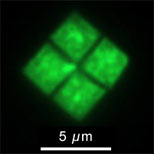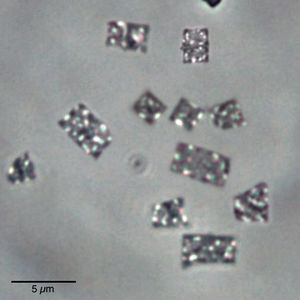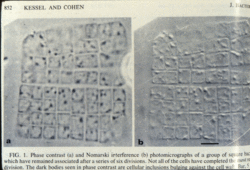Haloquadra: Difference between revisions
No edit summary |
No edit summary |
||
| (12 intermediate revisions by 3 users not shown) | |||
| Line 1: | Line 1: | ||
{ | {{Curated}} | ||
{{Biorealm Genus}} | |||
[[Image:FourSquares_AO_vs.jpg|thumb|300px|right|''<br /> | [[Image:FourSquares_AO_vs.jpg|thumb|300px|right|''<br /> Haloquadra walsbyi'' (or ''Haloquadratum walsbyi''). Image from Mike Dyall-Smith.]] | ||
==Classification== | ==Classification== | ||
| Line 10: | Line 8: | ||
===Higher order taxa:=== | ===Higher order taxa:=== | ||
Archaea, Euryarchaeota, Halobacteria, Halobacteriales, | Archaea, Euryarchaeota, Halobacteria, Halobacteriales, Halobacteriaceae, Haloquadra | ||
{| | |||
| height="10" bgcolor="#FFDF95" | | |||
'''NCBI: [http://www.ncbi.nlm.nih.gov/Taxonomy/Browser/wwwtax.cgi?id=182779 Taxonomy] Genome''' | |||
|} | |||
==Description and Significance== | ==Description and Significance== | ||
(According to recent literature (Maturrano et al., "Microbial Diversity in Maras Salterns, a Hypersaline Environment in the Peruvian Andes"), the genus of ''Haloquadratum walsbyi'' has been changed to ''Haloquadra''. Thus, the name of this article, as well as the name of the species being referenced, have been changed accordingly.) | |||
The archaeon with the proposed name ''Haloquadra walsbyi'' ("salt squares of Walsby") was first discovered in 1980 by A.E. Walsby in the Gavish Sabkha, a coastal brine pool in the Sinai peninsula, Egypt. The "square haloarchaea of Walsby" were notable because of their extremely thin (around 0.15 μm), square-shaped structure. While this archaeon was discovered in 1980, it was not successfully cultivated in the lab until 2004; before then it had been considered to be an unculturable organism. In the attempts to culture ''Haloquadra walsbyi'', a new member of the ''[[Haloarcula]]'' genus, ''Haloarcula quadra'', was isolated. Haloquadra are interesting to scientists because of their unique shape, their motility, and their relative abundance in halophilic habitats, possibly signifying an important ecophysiological role. | |||
==Genome Structure== | ==Genome Structure== | ||
'' | ''Haloquadra walsbyi'''s 16S rDNA provided scientists with a definite answer as to the organism's taxonomy; however the species' complete genome has yet to be sequenced. The mapping of the organism's 3.1 Mb large genome is underway; once this sequence is complete, scientists will have a better understanding of the role ''Haloquadra walsbyi'' plays in its ecosystem. | ||
==Cell Structure and Metabolism== | ==Cell Structure and Metabolism== | ||
[[Image:IsolateC23_MMKpyr_Sept04.jpg|thumb|300px|left| Unique square cells of '' | [[Image:IsolateC23_MMKpyr_Sept04.jpg|thumb|300px|left| Unique square cells of ''Haloquadra walsbyi''. Image from Mike Dyall-Smith.]] | ||
'' | ''Haloquadra walsbyi'' has a unique cell shape--that of an extremely thin square, its best-known characteristic. The cells possess an abundance of intracellular refractile bodies known as ''gas vacuoles''- vacuoles filled with gas which provide buoyancy- maintaining upper position in the water column. Individual square cells are joined with others to form large sheets, sometimes as large as 40 microns. These sheets are extremely fragile and the connections between the cells are easily broken. | ||
The cells are motile by flagella, of which they can have anywhere between one and several located all over the cell surface. The flagella rotate clockwise to propel the cell forward; counterclockwise to move in reverse. Its mode of metabolism is not completely known; complete genetic information will give researchers necessary insight. | The cells are motile by flagella, of which they can have anywhere between one and several located all over the cell surface. The flagella rotate clockwise to propel the cell forward; counterclockwise to move in reverse. Its mode of metabolism is not completely known; complete genetic information will give researchers necessary insight. | ||
| Line 29: | Line 34: | ||
==Ecology== | ==Ecology== | ||
'' | ''Haloquadra walsbyi'' was first noticed and taken from saline pools in Egypt, but it can be found in hypersaline bodies of water all over the world. Evaporation of water in these pools leaves high concentrations of salt, making for ''Haloquadra walsbyi'''s optimal growth environment. According to [http://www.blackwell-synergy.com/doi/full/10.1111/j.1462-2920.2004.00692.x Bolhuis et al.], "In this sense, they are the most hyperhalophilic organisms known, as further concentration of the magnesium salts (bitterns) leads to sterility of the brines." Their precise role in the ecosystem is not known for sure, but because of its unique morphology learning more about it will surely provide some information on the evolution and morphological adaptation of archaeans. | ||
[[Image:SHOW_Kessel_L.gif|thumb|250px|right|Images of the 2D, square sheets formed by the joining of '' | [[Image:SHOW_Kessel_L.gif|thumb|250px|right|Images of the 2D, square sheets formed by the joining of ''Haloquadra walsbyi'' cells. Image from ''Nature''(London) by Kessell and Cohen, 1982.]] | ||
==References== | ==References== | ||
[http://www.ncbi.nlm.nih.gov/entrez/query.fcgi?cmd=Retrieve&db=PubMed&list_uids=6526006&dopt=Citation Alam, M. et al. Flagella and motility behaviour of square bacteria. ''European Molecular Biology Organization Journal'' vol 3 1984. 2899-2903.] | [http://www.ncbi.nlm.nih.gov/entrez/query.fcgi?cmd=Retrieve&db=PubMed&list_uids=6526006&dopt=Citation Alam, M. et al. Flagella and motility behaviour of square bacteria. ''European Molecular Biology Organization Journal'' vol 3 1984. 2899-2903.] | ||
[http://www.blackwell-synergy.com/doi/full/10.1111/j.1462-2920.2004.00692.x Bolhuis et al. "Isolation and cultivation of Walsby's square archaeon." ''Environmental Microbiology'' 6.12 (2004): 1287] | |||
Burns et al. "Cultivation of Walsby's square haloarchaeon." ''FEMS Micribiology Letters'' 238 (2004): 469-473. | |||
Dyall-Smith, Mike. The Square Haloarchaea of Walsby--one of the weirdest extremophiles. Department of Microbiology and Immunology, University of Melbourne. | Dyall-Smith, Mike. The Square Haloarchaea of Walsby--one of the weirdest extremophiles. Department of Microbiology and Immunology, University of Melbourne. | ||
[http://www.biochem.mpg.de/oesterhelt/genomics/intro_Hqwal.html ''Haloquadratum walsbyi''. Department of Membrane Biochemistry, Max Planck Institute of Biochemistry.] | [http://www.biochem.mpg.de/oesterhelt/genomics/intro_Hqwal.html ''Haloquadratum walsbyi''. Department of Membrane Biochemistry, Max Planck Institute of Biochemistry.] | ||
Maturrano et al. "Microbial Diversity in Maras Salterns, a Hypersaline Environment in the Peruvian Andes." ''Applied and Environmental Microbiology'' 72.6 (2006): 3887-3895. | |||
[http://ijs.sgmjournals.org/cgi/reprint/49/3/1149 Oren, Aharon et al. ''Haloarcula quadrata'' sp. nov., a square, motile archaean isolated from a brine pool in Sinai (Egypt). ''International Journal of Systematic Bacteriology'' vol 49 1999. 1149-1155.] | [http://ijs.sgmjournals.org/cgi/reprint/49/3/1149 Oren, Aharon et al. ''Haloarcula quadrata'' sp. nov., a square, motile archaean isolated from a brine pool in Sinai (Egypt). ''International Journal of Systematic Bacteriology'' vol 49 1999. 1149-1155.] | ||
Latest revision as of 21:07, 6 August 2010
A Microbial Biorealm page on the genus Haloquadra
Classification
Higher order taxa:
Archaea, Euryarchaeota, Halobacteria, Halobacteriales, Halobacteriaceae, Haloquadra
|
NCBI: Taxonomy Genome |
Description and Significance
(According to recent literature (Maturrano et al., "Microbial Diversity in Maras Salterns, a Hypersaline Environment in the Peruvian Andes"), the genus of Haloquadratum walsbyi has been changed to Haloquadra. Thus, the name of this article, as well as the name of the species being referenced, have been changed accordingly.)
The archaeon with the proposed name Haloquadra walsbyi ("salt squares of Walsby") was first discovered in 1980 by A.E. Walsby in the Gavish Sabkha, a coastal brine pool in the Sinai peninsula, Egypt. The "square haloarchaea of Walsby" were notable because of their extremely thin (around 0.15 μm), square-shaped structure. While this archaeon was discovered in 1980, it was not successfully cultivated in the lab until 2004; before then it had been considered to be an unculturable organism. In the attempts to culture Haloquadra walsbyi, a new member of the Haloarcula genus, Haloarcula quadra, was isolated. Haloquadra are interesting to scientists because of their unique shape, their motility, and their relative abundance in halophilic habitats, possibly signifying an important ecophysiological role.
Genome Structure
Haloquadra walsbyi's 16S rDNA provided scientists with a definite answer as to the organism's taxonomy; however the species' complete genome has yet to be sequenced. The mapping of the organism's 3.1 Mb large genome is underway; once this sequence is complete, scientists will have a better understanding of the role Haloquadra walsbyi plays in its ecosystem.
Cell Structure and Metabolism
Haloquadra walsbyi has a unique cell shape--that of an extremely thin square, its best-known characteristic. The cells possess an abundance of intracellular refractile bodies known as gas vacuoles- vacuoles filled with gas which provide buoyancy- maintaining upper position in the water column. Individual square cells are joined with others to form large sheets, sometimes as large as 40 microns. These sheets are extremely fragile and the connections between the cells are easily broken.
The cells are motile by flagella, of which they can have anywhere between one and several located all over the cell surface. The flagella rotate clockwise to propel the cell forward; counterclockwise to move in reverse. Its mode of metabolism is not completely known; complete genetic information will give researchers necessary insight.
Ecology
Haloquadra walsbyi was first noticed and taken from saline pools in Egypt, but it can be found in hypersaline bodies of water all over the world. Evaporation of water in these pools leaves high concentrations of salt, making for Haloquadra walsbyi's optimal growth environment. According to Bolhuis et al., "In this sense, they are the most hyperhalophilic organisms known, as further concentration of the magnesium salts (bitterns) leads to sterility of the brines." Their precise role in the ecosystem is not known for sure, but because of its unique morphology learning more about it will surely provide some information on the evolution and morphological adaptation of archaeans.
References
Burns et al. "Cultivation of Walsby's square haloarchaeon." FEMS Micribiology Letters 238 (2004): 469-473.
Dyall-Smith, Mike. The Square Haloarchaea of Walsby--one of the weirdest extremophiles. Department of Microbiology and Immunology, University of Melbourne.
Haloquadratum walsbyi. Department of Membrane Biochemistry, Max Planck Institute of Biochemistry.
Maturrano et al. "Microbial Diversity in Maras Salterns, a Hypersaline Environment in the Peruvian Andes." Applied and Environmental Microbiology 72.6 (2006): 3887-3895.



